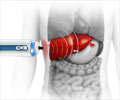Non-alcoholic fatty liver disease (NAFLD) is a common condition associated with obesity and heart disease long thought to undermine health and longevity.

"Physicians have considered fatty liver disease a really worrisome risk factor for cardiovascular disease," says study leader Mariana Lazo, M.D., Ph.D., a postdoctoral fellow at the Johns Hopkins University School of Medicine's Welch Center for Prevention, Epidemiology, and Clinical Research. "Our data analysis shows this doesn't appear to be the case. We were surprised to say the least because we expected to learn by how much non-alcoholic fatty liver disease increased the risk of death and instead found the answer was not at all."
Using health information collected from 11,371 Americans between 1994 and 1998 and followed for up to 18 years as part of the Third National Health and Nutrition Examination Survey (NHANES III), the researchers checked liver enzyme levels and ultrasound tests for evidence of NAFLD, and ultimately looked at death rates associated with NAFLD. The participants ranged in age from 20 to 74 during the data collection years. Because the ultrasounds were originally taken to assess gallbladder health, Lazo and colleagues from Johns Hopkins looked at each recording to determine the presence of fat in each person's liver. People whose livers are 5 percent fat or more are considered to have NAFLD.
The Johns Hopkins team found no increase in mortality among those with NAFLD, which was identified in approximately 20 percent of the NHANES participants. At the end of the follow-up period, mortality from all causes was 22 percent, or 1,836 individuals. Cardiovascular disease was the cause of death for 716 participants, cancer for 480 and liver disease for 44.
Although the researchers found no increase in deaths, Lazo says further study is needed to determine whether more advanced NAFLD has serious long-term consequences for the liver, a vital organ that turns what we eat and drink into nutrients and filters harmful substances from the blood.
NAFLD, which some researchers have called the nation's next epidemic, is characterized by the liver's inability to break down fats and fatty build up in the organ. Found in roughly one in three Americans, it is most prevalent in those who are obese, and those with diabetes and cardiovascular disease. The spectrum of disease ranges from simple fat build-up to inflammation to the scarring and poor liver function that characterize cirrhosis. Chronic liver disease has long been associated with long-term alcohol consumption, but as the name suggests, NAFLD is found in those who are not heavy drinkers.
Advertisement
There is no treatment for NAFLD, other than lifestyle changes, including weight loss, and only a liver biopsy can determine how serious NAFLD is. Lazo says she hopes new methods are developed that more easily identify more advanced stages of NAFLD, which may not be harmless.
Source-Eurekalert















